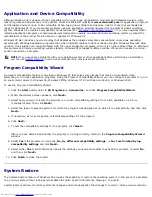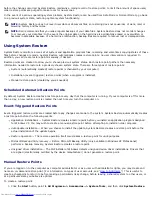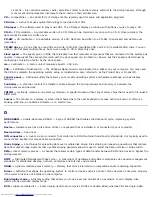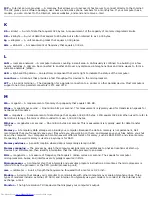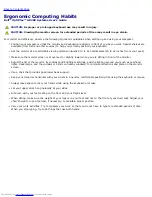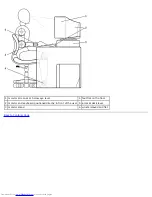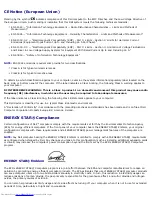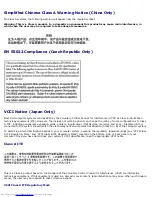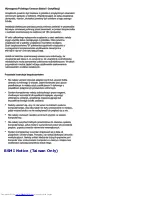
RAID —
redundant array of independent disks — A system of two or more drives working together for performance and fault
tolerance. RAID drives are typically used on servers and high-end PCs.
RAM —
random-access memory — The primary temporary storage area for program instructions and data. Any information
stored in RAM is lost when you turn off your computer.
Readme file —
A text file included with a software package or hardware product. Typically, readme files provide installation
information and describe new product enhancements or corrections that have not yet been documented.
Read-Only —
Data and/or files you can view but cannot edit or delete. A file can have read-only status if:
It resides on a physically write-protected floppy disk.
It is located on a network in a directory and the system administrator has assigned rights only to specific
individuals.
Refresh rate —
The frequency, measured in Hz, at which your screen's horizontal lines are recharged (sometimes also
referred to as its vertical frequency). The higher the refresh rate, the less video flicker can be seen by the human eye.
Resolution —
The sharpness and clarity of an image produced by a printer or displayed on a monitor. The higher the
resolution, the sharper the image.
RFI —
radio frequency interference — Interference that is generated at typical radio frequencies, in the range of 10 kHz to
100,000 MHz. Radio frequencies are at the lower end of the electromagnetic frequency spectrum and are more likely to have
interference than the higher frequency radiations such as infrared and light.
ROM —
read-only memory — Memory that stores data and programs that cannot be deleted or written to by the computer.
ROM, unlike RAM, retains its contents after you turn off your computer. Some programs essential to the operation of your
computer reside in ROM.
RPM —
revolutions per minute — The number of rotations that occur per minute.
RTC —
real time clock — Battery-powered clock on the system board that keeps the date and time after you turn off the
computer.
RTCRST —
real time clock reset — A jumper on the system board that can often be used for troubleshooting problems.
S
ScanDisk —
A Microsoft utility that checks files, folders, and the hard drive's surface for errors. ScanDisk often runs after a
lockup occurs.
SDRAM —
synchronous dynamic random-access memory — A type of DRAM that is synchronized with the optimal clock speed
of the microprocessor.
Serial connector —
An I/O port often used to connect devices such as a handheld digital device or digital camera to your
computer.
Service tag —
A bar code label on your computer that identifies your computer when you access Dell | Support at
support.dell.com
or when you call Dell for customer or technical support.
Setup program —
A program that is used to install and configure hardware and software. The
setup.exe
or
install.exe
program comes with most Windows software packages. Setup program differs from system setup program.
Shortcut —
An icon that provides quick access to frequently used programs, files, folders, and drives. When you place a
shortcut on your Windows desktop and double-click the icon, you can open its corresponding folder or file without having to
find it first. Shortcut icons do not change the location of files. If you delete a shortcut, the original file is not affected. Also,
you can rename a shortcut icon.
Shutdown —
The process of closing windows and programs, exiting the operating system, and turning off your computer.
You can lose data if you turn off your computer before completing a shutdown.
Software —
Anything that can be stored electronically, such as computer files or programs.
Standby mode —
A power management mode that shuts down all unnecessary computer operations to save energy.
Surge protectors —
Prevents voltage spikes, such as those that may occur during an electrical storm, from entering the
system through the electrical outlet. They do not protect against lightning strikes or against brownouts, which occur when the
voltage drops more than 20 percent below the normal AC line voltage level.
Содержание GX260 - Optiplex Pentium 4 2.0GHz 512MB 40GB CD
Страница 6: ......
Страница 29: ......
Страница 37: ...Back to Contents Page ...
Страница 40: ...information on resetting the chassis intrusion detector Back to Contents Page ...
Страница 73: ......
Страница 76: ......
Страница 86: ...2 padlock ring 3 two release buttons one on each side Back to Contents Page ...
Страница 111: ......
Страница 128: ...1 release buttons 2 security cable slot 3 padlock ring Back to Contents Page ...
Страница 149: ...13 Verify that your computer works correctly by running the Dell Diagnostics Back to Contents Page ...
Страница 155: ...Back to Contents Page ...
Страница 186: ...Back to Contents Page ...
Страница 210: ...Back to Contents Page ...
Страница 232: ...BSMI Notice Taiwan Only ...


